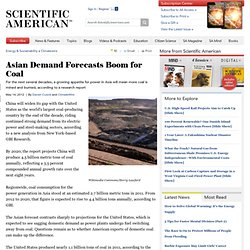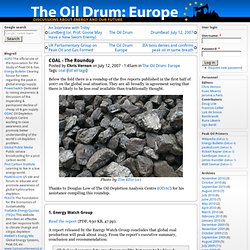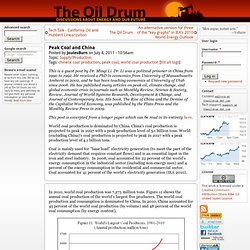

In Harm's Way: Coal Ash-Contaminated Sites. For more information on coal ash ponds and landfills in the southeast, please visit Southeast Coal Ash Waste, a website managed by our coalition partners at the Southern Alliance for Clean Energy Contaminated Site (182) Spill (14) Contaminated Site & Spill (12) Alabama (2)

China to Invest in Coal Gasification - with GEs help - OIL - eWallstreeter. Analysis: Germany's Merkel losing green battle to cheap coal. The Coal Sigils. Asian Demand Forecasts Boom for Coal. China will widen its gap with the United States as the world's largest coal-producing country by the end of the decade, riding continued strong demand from its electric power and steel-making sectors, according to a new analysis from New York-based GBI Research.

By 2020, the report projects China will produce 4.5 billion metric tons of coal annually, reflecting a 3.5 percent compounded annual growth rate over the next eight years. Regionwide, coal consumption for the power generation in Asia stood at an estimated 2.7 billion metric tons in 2011. From 2012 to 2020, that figure is expected to rise to 4.4 billion tons annually, according to GBI. The Asian forecast contrasts sharply to projections for the United States, which is expected to see sagging domestic demand as power plants undergo fuel switching away from coal.
Questions remain as to whether American exports of domestic coal can make up the difference. "India is a power-deficit country," the report notes. Coal and gas assets 'at top of Japan's shopping list' JAPAN will target more Australian coal and gas assets as it reduces its reliance on nuclear power, says a top-ranking member of the country's government.

Masayuki Naoshima - the vice-president of the Japanese upper-house, a former Minister of Economy, Trade and Industry and senior member of the the ruling Democratic Party of Japan - arrived in Australia last week to hold talks with the Prime Minister, Julia Gillard. During his visit he told BusinessDay that liquefied natural gas (LNG) and coal assets are on the top of Japan's shopping list. Japan turned off its last nuclear reactor at the weekend, in the wake of the accident at Fukushima in 2011. Advertisement ''Australia is one of the most important countries for Japan in terms of natural resources supply,'' Mr Naoshima said. Mr Naoshima said the Japanese investment in the Darwin-based $32 billion Ichthys gas export venture by Japanese oil and gas explorer Inpex Corp was an example of his country's appetite for LNG investment.
Coal. How much of the world’s electricity needs are provided by coal?

Does still coal contribute to the energy mix globally? As of March 2012, approximately 40% of the world’s electricity needs were provided by coal. Yes, coal is the second source of primary energy after oil. What are supercritical and ultra-supercritical plants? Supercritical (SC) and ultra-supercritical (USC) plants produce heat that drives water above the critical point where there is no difference between steam and liquid. Is coal production declining? No, far from it. World Coal Association. COAL - The Roundup. 1.

Energy Watch Group Read the report (PDF, 630 KB, 47 pp). A report released by the Energy Watch Group concludes that global coal production will peak about 2025. From the report's executive summary, conclusion and recommendation: Global coal reserve data are of poor quality, but seem to be biased towards the high side. Some of the report's conclusions: Data are of poor quality; Six countries dominate coal globally USA, Russia, India, China, Australia, South Africa; Fastest reserve depletion in China, USA beyond peak production.
If the report conclusions are correct, this is good news for climate change and bad news for the global economy. Click to Enlarge This report has been discussed and summarized by Richard Heinberg: Burning the Furniture And by Shaun Chamberlin on The Oil Drum: Peak Coal - Coming Soon? 2. Read the report (PDF, 1.7 MB, 52 pp). The report identifies three trends: The following observations are also made: 3. Read the report (PDF, 2.0 MB, 64 pp). Similarly titled, B. 4. 5. Coal_r&d_final. DavidRutledgeCoalGeology. Hubbert's Peak, The Coal Question. Peak Coal and China. In 2010, world coal production was 7,273 million tons.

Figure 11 shows the annual coal production of the world’s largest five producers. The world coal production and consumption is dominated by China. In 2010, China accounted for 45 percent of the world coal production (by volume) and 48 percent of the world coal consumption (by energy content). Figure 11 The BP Statistical Review of World Energy reports China’s coal reserves to be 114.5 billion tons. Tao and Li (2007) used China’s official coal reserves at the end of 2002 published by China’s Ministry of Land and Natural Resources and estimated that China’s coal production could peak between 2025 and 2032, and the peak production level was likely to be between 3.3 and 4.5 billion tons.
Kavalov - coal future - HOP_ 081107. The Future of Coal. Coal: Resources & Future Production.